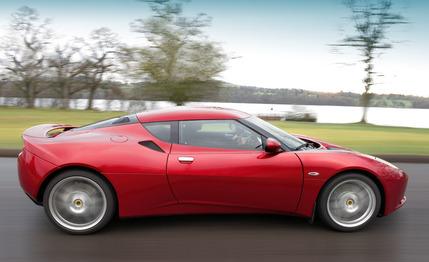
 First Drive Review
First Drive Review
There are few greater automotive thrills than hurling a Lotus Elise down a bendy back road—or around a racetrack. But it’s almost not fair to compare the intense and delightful responses of the Elise or the related Exige with other street cars because, with curb weights that hover around 2000 pounds, there aren’t really any other street cars like them.
Bigger, but No Less Special
As you likely already know, that’s where the Evora comes in. It’s massively larger than the Elise—21.9 inches longer, with a 10.9-inch stretch in the wheelbase—which puts it on par with other sports cars such as the Porsche 911 and Cayman. The Evora is roughly five inches shorter than the 911 but still manages to squeeze in similarly sized (i.e., tiny) back seats that are designed to fit very small adults or children up to about 10 years old. It also has a narrower doorsill and a 2.5-inch-higher seating position, making it far easier to get into and out of, which is one of the Elise’s setbacks. Two six-foot-plus males can sit in comfort without their shoulders touching, which is inevitable in an Elise. In fact, this six-foot-five driver didn’t even have to put the front seat back all the way to get comfortable.
Back seat or not, the Evora is still very much a Lotus in the driver-thrills department. As with the company’s other cars, the steering is absolutely brilliant. The Evora has hydraulic power assist as opposed to the unassisted racks of other Lotuses, but the magic still comes through. In fact, the Lotus guys are so fanatical about steering feel that the Evora has a magnesium steering wheel in order to reduce weight—and therefore inertia—so the driver is informed of every last road nuance. The weighting is perfect, and the constant subtle feedback that comes through the thin, flat-bottom wheel is superb without making the car feel nervous or twitchy.
More Than Just Power
The Evora is planted and secure, yet it picks apart corners with a light and playful feel that always makes mid-engine cars feel so special—think Ferrari F430, only with better steering. The Evora’s handling is so natural and fluid that you get the sense it actually enjoys being pushed. Braking is similarly spectacular, with immediate bite and extremely linear behavior. Despite weighing about 100 fewer pounds than a 911, the Evora wears 13.8-inch front brakes that are larger than the Porsche’s. Lotus says they’ve been designed to easily shrug off track use.
Although not necessarily a straight-line rocket—a Nissan 370Z will keep up in the quarter-mile dash—it isn’t as though the Evora is wanting for a bunch of additional power, and that’s not what any Lotus is about, anyway. The Toyota-sourced V-6 is responsive and has a nice midrange induction growl—Lotus routes a tube from the intake to the cabin to enhance the noise—and it sings a sophisticated but fairly subtle roar in the 5000-to-7000-rpm range. In fact, this is as loud as Lotus could make it to pass strict European noise regulations. U.S. cars get a slightly louder exhaust. A benefit of the, shall we say, responsible level of horsepower is impressive fuel economy numbers. Based on European ratings, the Evora could return as high as a 911-bettering 19 mpg city and 28 mpg highway in EPA testing.
Start Saving Now
Initially, the Evora will be offered only with a six-speed manual, but Toyota’s six-speed automatic transmission will be on the options list for 2011. Don’t worry—as with the engine, the autobox will be completely reprogrammed by Lotus. The Evora goes on sale imminently in Europe but won’t be available in the U.S. until early 2010, and the critical pricing decision has yet to be made. Current exchange rates would put the Evora at $75,000 or so, which is practically on top of the Porsche 911 and over $10,000 higher than the price of a Cayman S. That may be a tough sell for some. But the sales volume will be supercarlike, which means your neighbor—or anyone else on your drive to work—is not likely to have one, and the level of driver feedback is unsurpassed in the “real car” realm. That’s enough for us.